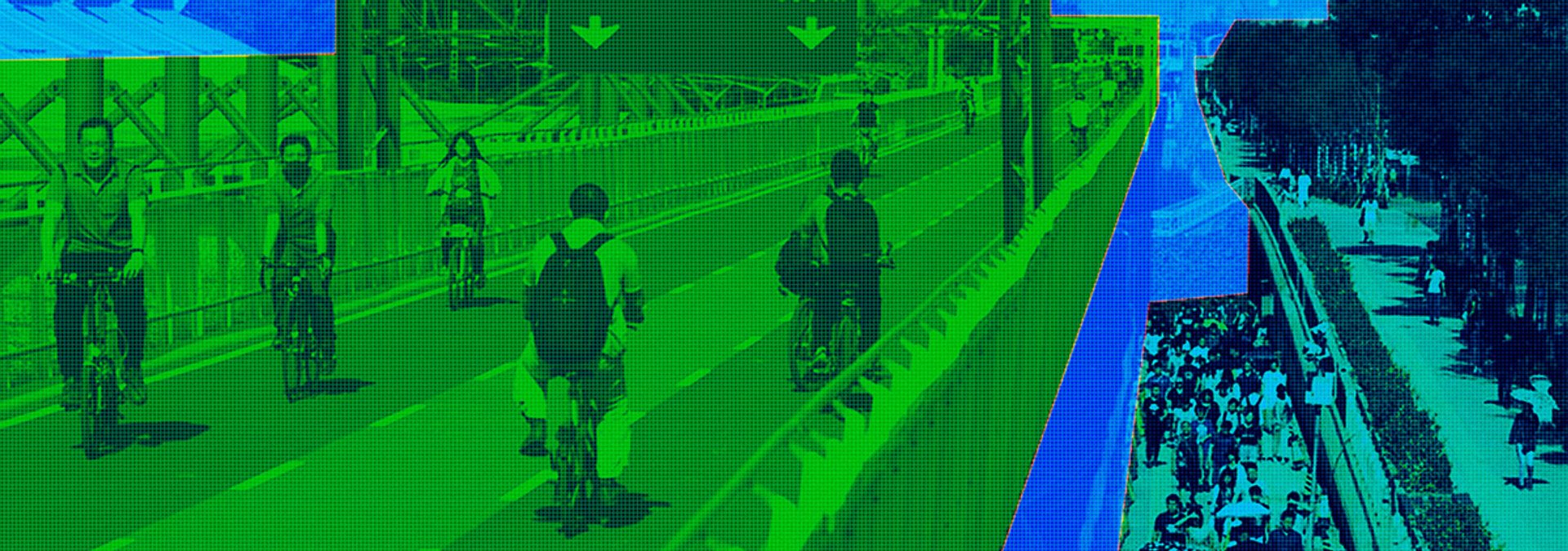
Freeways were built only for people like me. We need to build for everyone.
We should be able to choose how we move around. Our choices should range, because our lives range. Illustration: Evan O'Neil.
On Wednesdays, I would commute into Houston from our house in the northwestern suburbs with my parents for harp lessons. It was our ritual. We would talk and listen to music, and I would look out the window at the world flying past, safely buckled into the backseat, until I was lulled asleep during the long trip home.
My dad also took me down I-45 for Rockets games and dinners at restaurants owned not by conglomerates, but by Houstonians. We used that same freeway to get to museums, appointments with world-renowned specialists who were caring for our sick loved ones, farmers markets, classes, all inside Loop 610.
Some landmarks caught my attention, but the rest was a blur. Every once in a while, I remember, I’d take a second look at the bungalows, the grassy yards, the local streets, on the other side of the concrete barriers. It seemed so loud, so hot. But I assumed everyone knew what they were doing. Still, I remember wondering: Who would build their house right next to a freeway?
It wasn’t until I was 26 and in graduate school for public health that I learned: no one did. In fact, the freeways were built right on top of them.
***
I have now spent the better part of two years knocking on some of the same doors I used to speed past, walking up and down feeder roads from house to house, getting to know some of the people who stand to be impacted and displaced by the Texas Department of Transportation’s massive, expensive I-45 project, decades in the making, to add lanes and reroute interstates through the city.
I was right about one thing: it is hot, and it is loud. But I’ve also been let inside these homes to feel the tranquility that’s been created. I’ve smiled at shy children, scratched eager dog’s ears and seen lush backyards that struck me as sweet, quiet oases for families to gather for cookouts and birthday parties. “I don’t care if it floods,” one woman told me. “This is my home, and I don’t want to move.”
A man my age shared that his father lost a store when TxDOT originally built I-45. Now, he and his siblings could lose their home.
This is one of three essays written in response to the Texas Department of Transportation's proposed project to expand and reroute Interstate 45 through Houston. Read the others here and here.
If TxDOT moves forward with the project as designed, they will displace thousands of people like this. And hundreds of businesses, places of worship, schools and daycares, clinics and parks — all of which are in communities that suffered the original harms of the construction of I-45. Doing my homework — learning the problematic history of freeway construction, reading the news about other projects and encountering better ideas for transportation in U.S. cities — began to reshape my understanding of the narrative in Houston. With every meeting, during every conversation, I have been reminded of my place in this.
The freeways were built for me. I grew up in the suburbs and went to high school in The Woodlands, a forested land of three-car garages that, from above, looks like a fossil, carved up by dendritic streets encrusted with jewels of blue swimming pools in every yard. The freeways that connected us to the city that made The Woodlands possible, I know now, were built over and through the homes of people who stand to suffer the same reinjuries today, 60 years later, with TxDOT’s I-45 project.
Those who support the expansion justify it with the purported benefits to the suburban residents I was and the ones they project will move to the region. These benefits, they seem to believe, are worth the harm to the communities who are already here. But expansions like this harm all of us.
***
We know that widening freeways and adding capacity only serves to make traffic worse over time. It is a waste of your time, in other words. The headaches of a decade of construction will lead to the stress of a longer commute, packed in beside more cars. The Katy Freeway was widened, and people are forced to be in their cars longer now than they were before. Driving is far and away the most expensive, dangerous and unsustainable way for us to move around, but if that’s your only option, it’s not an option.
We should be able to choose how we move around. Our choices should range from walking to bicycling to taking transit to driving, because our lives range. We aren’t just going to and from work. We are meeting friends, we are picking up our children, we are filling prescriptions, we are going shopping. But TxDOT has built infrastructure that presumes we are only ever driving far and fast. When I try to make different choices, my friends wish me luck or insist on driving me, fearing my safety. And I live inside the Loop. People coming in from the exurbs and suburbs can leave early enough to beat the traffic, or they can sit in the traffic, but always, no matter what, they are the traffic.
Why does it have to be this way? We know TxDOT is limited by the Texas Constitution, which requires that the agency spend more than 90 percent of their revenue on building and maintaining roads. If the Texas Transportation Commission, TxDOT’s governing body comprising four wealthy, white people and one vacancy, suddenly decided to listen to cities or care about air quality or climate change, they could pivot.
But Section 49-g(c), Article III, of the constitution gives them a very comfortable excuse not to. This summer, I went with 15 other Houstonians, ranging from ages 23 to 82, to Austin to speak up in support of a proposed amendment to that constitution that would allow TxDOT to build and maintain the choices we want in our city. We sacrificed work time, asked siblings to take care of our aging parents and hired pet sitters to wait for eight hours at the capitol to try to change this narrative.
It harms all of us. A freeway expansion shaves away vibrant neighborhoods. It reduces the city’s tax base. Its construction depends on industrial facilities that pollute the air and water. It splits apart the urban cores that are the gravitational center of any metropolitan area, allowing suburbs to orbit them. Why did my parents move to Houston in the first place? So I could grow up benefitting from the opportunities and amenities of both the suburbs and Houston’s urban core.
If you chip away at the neighborhoods in that core, if you divide them with infrastructure into smaller and smaller pieces, if you render them less habitable by paving over them and filling our air with even more toxic, harmful emissions, you are arresting the heartbeat of the very city that attracts us here.
I never knew. I never understood my place in this structure. No one explained the consequences of building and using freeways in Houston. There is still little understanding of them and the choices we aren’t being given. But the acceptance of TxDOT’s singular insistence on pursuing infrastructure that supports only one way of moving around the city makes us complicit in the harm that could be brought down on those who stand to have their houses taken away and their air ruined.
It doesn’t matter where you live. The expansion represents a loss, a rejection of choices. We have the power to demand them. We have the power to tell TxDOT that we value equity, sustainability, comfort and access. We can’t keep speeding past our neighbors, blind to the connections between us.
Cook is a certified emergency nurse with a dual master's degree in nursing and public health. She has worked in the Texas Medical Center since 2014 and lives in Montrose.
STAY UP TO DATE
The quality of our newsletter is considered satisfactory and poses little or no risk.
SUBSCRIBE

